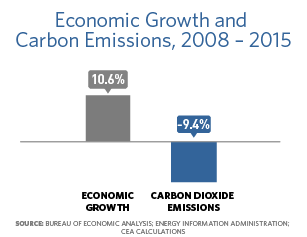
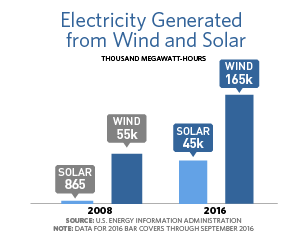
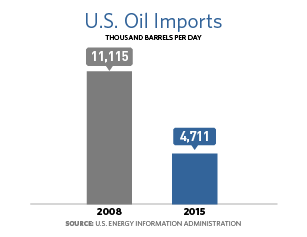
President Obama believes that no challenge poses a greater threat to our children, our planet, and future generations than climate change — and that no other country on Earth is better equipped to lead the world towards a solution.
That’s why under President Obama’s leadership, the United States has done more to combat climate change than ever before, while growing the economy. In fact, since the President took office, carbon emissions have decreased 9 percent, while the U.S. economy grew more than 10 percent.



Reducing Carbon Pollution in Our Power Plants
Reducing Carbon Pollution in Our Power Plants → https://www.youtube.com/watch?v=li1aHjjqh3wTogether, these standards will avoid more than 8 billion tons of carbon pollution while saving families and businesses nearly $2 trillion over the lives of the vehicles.
Remarks by the President on Fuel Efficiency Standards of Medium and Heavy-Duty Vehicles, February 19, 2014
"And improving gas mileage for these trucks are going to drive down our oil imports even further. That reduces carbon pollution even more, cuts down on businesses’ fuel costs, which should pay off in lower prices for consumers. So it’s not just a win-win, it’s a win-win-win."
Memo on Appliance Efficiency Standards
As of the latest round of pledges in December 2015, 154 businesses — with operations in all 50 states, employing nearly 11 million people, representing more than $4.2 trillion in annual revenue, and $7 trillion in market capitalization— are committed to support the Paris climate process.
White House Announces Additional Commitments to The American Business Act on Climate Pledge
The EPA announced proposed standards to directly reduce methane emissions from the oil and gas sector to help address climate change:
FACT SHEET: Obama Administration and Private-Sector Leaders Announce Ambitious Commitments and Robust Progress to Address Potent Greenhouse Gases
FACT SHEET: Reducing Greenhouse Gas Emissions in the Federal Government and Across the Supply Chain
Recognizing the role that forests and agricultural activities place in GHG emissions, in April 2015, USDA announced its Building Blocks for Climate-Smart Agriculture and Forestry—voluntary and incentive-based programs to reduce GHG emissions from agricultural production, increase carbon storage in our forests and soils, and generate clean, renewable energy. These actions will foster resilient economies and food systems, while also reducing emissions and improving environmental conditions.
Climate Change and the Land Sector: Improving Measurement, Mitigation and Resilience of our Natural Resources
The report, which is a key due-out of the Paris Agreement, illustrates the pathways to achieve an 80 percent economy-wide emissions reduction below 2005 levels by 2050 – consistent with the global ambition necessary to avoid the most costly climate impacts and catastrophic risks.
U.S. Mid-Century Strategy for Deep Decarbonization
Get the full list of schools standing behind this pledge:
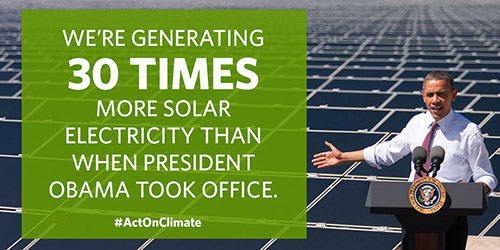
DOE’s SunShot Initiative launched in 2011 to drive down the cost of solar, and after achieving over 90% of the cost reductions towards the 2020 goal in 2016, launched a new goal with increased ambition for 2030.
And DOE’s Revolution Now report shows how far a range of key technologies have come in reducing costs and increasing deployment.
In 2009, there were no solar projects built on public lands and no method to address industry’s growing interest in developing renewable energy projects onshore or offshore.
Today, some of the world’s largest solar projects are powering the grid from public and tribal lands; we have a blueprint for responsible solar development in the West; and we’ve institutionalized a competitive renewable energy leasing program within the Bureau of Land Management. In a span of eight years, we approved 60 commercial-scale renewable energy projects on public lands that have the potential to produce 15,500 megawatts, enough to power approximately five million American homes. That’s progress.
Established the nation’s first program for offshore wind leasing and permitting. We identified wind energy areas that will allow our nation to capture substantial energy potential, without compromising fishing, recreation, national security, or environment. In 2016, the nation’s first offshore wind farm went operational off the coast of Rhode Island, and we have awarded eleven commercial leases along the Atlantic seaboard, covering over one million acres in federal waters, which with other projects could unlock up to 86 gigawatts of offshore wind in the U.S. by 2050.
In President Obama's first term, DOE and HUD completed efficiency upgrades in nearly two million homes, saving many families more than $400 on their heating and cooling bills in the first year alone.
Mobilizing $4 Billion in Private-Sector Support for Homegrown Clean-Energy Innovation
FACT SHEET: President Obama Announces New Actions to Bring Renewable Energy and Energy Efficiency to Households across the Country
Last year, the United States brought online as much solar energy every three weeks as it did in all of 2008, and the solar industry added jobs 10 times faster than the rest of the economy. Since the beginning of 2010, the average cost of a solar electric system has dropped by 50 percent. In fact, distributed solar prices fell 10 to 20 percent in 2014 alone and currently 44 states have pricing structures that encourage increased penetration of distributed energy resources.
President Obama unlocked access to Property Assessed Clean Energy (PACE) financing, making it easier to invest in energy efficiency and renewable energy at no up-front cost.
Watch the story of Ida Rhyne, a Baltimore resident who became the first person on her block to solar panels installed on her home thanks to this intiative.
FACT SHEET: Obama Administration Announces Clean Energy Savings for All Americans Initiative
FACT SHEET: Obama Administration Announces New Actions to Bring Clean Energy Savings to All Americans
U.S. Department of Energy: Property-Assessed Clean Energy Programs
USDA Invested Hundreds of Millions of Dollars to Help Hundreds of Small Businesses Improve Energy Efficiency, Adopt Renewable Energy Systems
President Obama is committed to improving the nation’s electric grid and spurring the development of renewable energy. The Administration announced new investments in the next generation of power transmission and smart grid technology in 13 states and executive actions that will make it easier and faster to permit transmission lines.
DOD Defense Department has implemented a number of energy efficiency and renewable energy technologies, underscoring the significant and inherent connection between energy independence and national security. Our Army, Navy, Air Force and Marines are deploying innovations in energy efficient technology, operational procedures, and renewable energy to improve combat capability and extend operational reach. This includes solar panels that power mobile artillery, fuel efficient tactical vehicles, and command-and-control systems that enable commanders to extend operational reach and reduce the number of vulnerable replenishment convoys. The Army, Navy and Air Force are also deploying three gigawatts of renewable energy on their installations by 2025 – enough to power 750,000 homes.
FACT SHEET: President Obama’s 21st Century Clean Transportation System
Obama Administration Announces New Actions to Accelerate The Deployment of Electrical Vehicles and Charging Infrastructure
Here’s Why You Should Care About Alternative Fuel Corridors
Electric Vehicles Can Lower Emissions and Enhance Resiliency
Electric vehicles can be used to shorten or end power outages by plugging their reserves into the grid. This is the kind of innovation we need to take action on climate change — both reducing emissions and boosting climate resilience.
President Obama’s Plan to Win the Future by Making American Businesses More Energy Efficient through the “Better Buildings Initiative”
Chart of the Week: We’re Using More Clean Energy than Ever Before
Remarks by the President on Jobs in Solar Energy
April 03, 2015
"I'm announcing a new goal to train 75,000 workers to enter the solar industry by 2020. As part of this, we’re creating what we’re calling a “Solar Ready Vets” program that’s modeled after some successful pilot initiatives that have already been established over the last several years. It's going to train transitioning military personnel for careers in this growing industry at 10 bases — including right here at Hill.
"And as part of this effort, we’re also going to work with states to enable more veterans to use the Post-9/11 GI Bill for solar job training. And it’s one of the many steps that we’re taking to help nearly 700,000 veterans and military spouses get a job. In fact, about 30 percent of the federal workforce is now made up of veterans. I’ve said it before, and I think employers are starting to catch on, if you really want to get the job done, hire a veteran."
President Obama Speaks on American Energy
FACT SHEET: Administration Announces New Agenda To Modernize Energy
"Today at the White House, the Departments of the Navy, Agriculture and Energy announced new contracts to construct and commission biorefineries capable of producing drop-in, military-compatible fuels that can be used in our most advanced warfighting platforms and by commercial industry. Together, the three companies receiving the awards will produce more than 100 million gallons of military grade fuel – at a price that’s competitive with fossil fuel."
The United States is undergoing a rapid energy transformation, particularly in the power sector. Booming natural gas production, declining costs for renewable energy, increases in energy efficiency, flattening electricity demand, and updated clean air standards are changing the way electricity is generated and used across the country. These trends are producing cleaner air and healthier communities, and spurring new jobs and industries. At the same time, they are impacting workers and communities who have relied on the coal industry as a source of good jobs and economic prosperity, particularly in Appalachia, where competition with other coal basins provides additional pressure. To help these communities adapt to the changing energy landscape and build a better future the President’s FY 2016 Budget proposed the POWER Plus (POWER+) Plan.
REPORT: Climate Action Plan Progress Report
President Obama Speaks on American Energy
President Obama announces new steps to help generate more clean energy, waste less energy overall, and leave our kids and our grandkids with a cleaner, safer planet in the process.
Learn more about ARPA-e, the Advanced Research Projects Agency for Energy
FACT SHEET: Winning the Future through Innovation
Learn more about Energy Innovation Hubs started under the Obama Administration
Learn more about the Quadrennial Energy Review here.
Keeping America’s Energy System on the Cutting Edge.
Learn more about Innovating to Protect Our Waterways
This new global framework lays the foundation for countries to work together to put the world on a path to keeping global temperature rise well below 2 degrees Celsius and sets an ambitious vision to go even farther than that. This Agreement sends a strong signal to the private sector that the global economy is moving towards clean energy, and that through innovation and ingenuity, we can achieve our climate objectives while creating new jobs, raising standards of living and lifting millions out of poverty.
The Paris Agreement is also the culmination of a broader effort by nations, businesses, cities, and citizens to reorient the global economy to a path of low-carbon growth – progress that will accelerate as a result of the Agreement’s provisions on mitigation ambition, transparency, and climate finance.
Remarks by the President on the Paris Agreement
"Today is a historic day in the fight to protect our planet for future generations.
"Ten months ago, in Paris, I said before the world that we needed a strong global agreement to reduce carbon pollution and to set the world on a low-carbon course. The result was the Paris Agreement. Last month, the United States and China -- the world’s two largest economies and largest emitters -- formally joined that agreement together. And today, the world has officially crossed the threshold for the Paris Agreement to take effect.
"Today, the world meets the moment. And if we follow through on the commitments that this agreement embodies, history may well judge it as a turning point for our planet."
FACT SHEET: Nearly 200 Countries Reach a Global Deal to Phase Down Potent Greenhouse Gases and Avoid Up to 0.5°C of Warming
This announcement is a unique development in the U.S.-China relationship. The world’s two largest economies, energy consumers, and carbon emitters are reaching across traditional divides and working together to demonstrate leadership on an issue that affects the entire world.
By making this announcement well in advance of the deadline set out in the UNFCCC negotiations, the two leaders demonstrated their commitment to reducing the harmful emissions warming our planet, and encouraged other world leaders to follow suit in offering strong national targets ahead of the final negotiations in Paris.
In November 2014, President Barack Obama and President Xi Jinping stood together in Beijing to make a historic U.S.-China Joint Announcement on Climate Change, emphasizing their personal commitment to a successful climate agreement in Paris and marking a new era of multilateral climate diplomacy as well as a new pillar in their bilateral relationship. On the occasion of President Xi’s State Visit to Washington, D.C., the two Presidents reaffirm their shared conviction that climate change is one of the greatest threats facing humanity and that their two countries have a critical role to play in addressing it.
FACT SHEET: 191 Countries Reach a Global Climate Deal for International Aviation
FACT SHEET: U.S. Leadership in Securing First-Ever Global Carbon Emissions Standards for Commercial Airplanes
Collaborating with 20 private investors from around the world that launched the Breakthrough Energy Coalition, which culminated in 2016 with the launch of Breakthrough Energy Ventures, a $1 billion dollar fund to invest in developing clean energy technologies.
Through the initiative, 20 countries are committing to double their respective clean energy research and development (R&D) investment over five years. These countries include the top five most populous nations – China, India, the United States, Indonesia, and Brazil. They stretch across five continents. And when you add all partner countries together, they represent 75 percent of the world’s CO2 emissions from electricity, and more than 80 percent of the world’s clean energy R&D investment. These additional public resources will be supported by the Breakthrough Energy Coalition, an independent effort by 28 top private investors from around the world, led by Bill Gates, to commit unprecedented levels of private capital to help bring breakthrough energy technologies to the market in Mission Innovation member countries.
The Administration also released a Framework for Mission Innovation, which outlines examples of proven and powerful approaches to research, development, and demonstration of breakthrough technologies that will be critical elements to the U.S. domestic implementation of Mission Innovation.
FACT SHEET: United States Support for Global Efforts to Combat Carbon Pollution and Build Resilience
United States and Other Countries to Work Together on Phase Down of HFCs
The United States is work together and with other countries to use the expertise and institutions of the Montreal Protocol to phase down the consumption and production of hydrofluorocarbons (HFCs), among other forms of multilateral cooperation. A global phase down of HFCs could potentially reduce some 90 gigatons of CO2 equivalent by 2050, equal to roughly two years worth of current global greenhouse gas emissions.
Secretary of State John Kerry announced that the United States will double its grant-based, public climate finance for adaptation by 2020. As of 2014, the United States invested more than $400 million per year of grant-based resources for climate adaptation in developing countries. These investments provide vulnerable countries with support — through both bilateral and multilateral channels — to reduce climate risks in key areas, including infrastructure, agriculture, health and water services.
"APEC joined the G20 in sending an unequivocal message that we need to reach an ambitious climate change agreement in Paris. I also want to note the landmark step we took this week with more than 30 other nations at the OECD to dramatically reduce subsidies for coal-fired power plants around the world — which is an important way to advance the fight against climate change." -—President Obama
U.S.-Brazil Joint Statement on Climate Change
FACT SHEET: U.S.-Indonesia Climate Cooperation
Fact Sheet: U.S. and India Climate and Clean Energy Cooperation
FACT SHEET: The United States and India – Moving Forward Together on Climate Change, Clean Energy, Energy Security, and the Environment
FACT SHEET: The President’s Climate Data Initiative: Empowering America’s Communities to Prepare for the Effects of Climate Change
FACT SHEET: United States Key Deliverables for the 2016 North American Leaders’ Summit
Announced initiatives to enhance North America’s economic competitiveness; expand our efforts on climate change, clean energy, and the environment; solidify our regional and global cooperation; and strengthen our security and defense.
U.S.-Canada Joint Statement on Climate, Energy, and Arctic Leadership
President Barack Obama and Prime Minister Justin Trudeau share a common vision of a prosperous and sustainable North American economy, and the opportunities afforded by advancing clean growth.
These contributions to the LDCF will continue supporting priorities identified by recipient countries that are essential for climate-resilient sustainable development and livelihoods.
The Climate Services for Resilient Development Partnership, initially announced by the President at the UN Climate Summit in New York last September, will provide actionable science, data, information, tools, and training to developing countries that are working to strengthen their national resilience against the impacts of climate change. The Partnership is launching with more than $34 million in financial and in-kind contributions from the U.S. government and seven other founding-partner institutions from around the world: the American Red Cross, Asian Development Bank, Esri, Google, Inter-American Development Bank, the Skoll Global Threats Fund, and the U.K. government.
Expanding Climate Risk Insurance in Developing Countries:
This announcement is an important step toward the goal G-7 leaders set this summer to increase by up to 400 million the number of people in the most vulnerable developing countries who will have access to insurance against the negative impacts of related hazards by 2020.
Unleashing Data and Tools to Boost Climate Resilience in India
New Elevation Map Details Alaska like Never Before
Promoting Green Goods Trade to Address Climate Change
Executive Order -- Climate-Resilient International Development
Promoting Green Goods Trade to Address Climate Change
President Obama Announces Historic 54.5 mpg Fuel Efficiency Standard
Remarks by the President at Bill Signing of the Frank R. Lautenberg Chemical Safety for the 21st Century Act
"The Frank R. Lautenberg Chemical Safety Act for the 21st Century will make it easier for the EPA to review chemicals already on the market, as well as the new chemicals our scientists and our businesses design. It will do away with an outdated bureaucratic formula to evaluate safety, and instead focus solely on the risks to our health. And it will finally grant our scientists and our public servants at the EPA the funding they need to get the job done and keep us safe."
EPA Strengthens Ozone Standards to Protect Public Health/Science-based standards to reduce sick days, asthma attacks, emergency room visits, greatly outweigh costs:
Released a national Clean Water Framework that recognizes the importance of clean water and healthy watersheds to our economy, environment and communities, and emphasizes the importance of partnerships and coordination with states, local communities, stakeholders, and the public to protect public health and water quality, and promote the nation’s energy and economic security.
“With today’s rule, we take another step towards protecting the waters that belong to all of us.” — President Obama on finalizing the Clean Water Rule
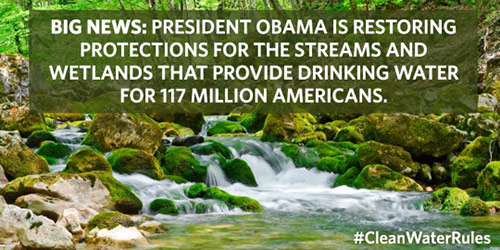
The Department of the Interior announced final well control regulations to reduce the risk of an offshore oil or gas blowout that could result in the loss of life, serious injuries or substantial harm to the environment.
The Department of the Interior announced final regulations to ensure that any future exploratory drilling activities on the U.S. Arctic Outer Continental Shelf (OCS) are conducted under the highest safety and environmental standards and subject to strong and proven operational requirements.
2017-2022 OCS Oil and Gas Leasing Program offers 70 percent of economically recoverable resources while ensuring protection of critical areas, including the Arctic.
Presidential Memorandum -- Withdrawal of Certain Areas of the United States Outer Continental Shelf Offshore Alaska from Leasing Disposition
President Obama’s Plan to Win the Future by Making American Businesses More Energy Efficient through the “Better Buildings Initiative”
Memo on Appliance Efficiency Standards
We’re Using More Clean Energy than Ever Before:
Announcing $4 billion in new clean energy commitments from investors and foundations.
In President Obama's first term, DOE and HUD completed efficiency upgrades in nearly two million homes, saving many families more than $400 on their heating and cooling bills in the first year alone.
"As part of his Climate Action Plan, President Obama signed an Executive Order on November 1st, 2013 establishing a Task Force on Climate Preparedness and Resilience to advise the Administration on how the Federal Government can respond to the needs of communities nationwide that are dealing with the impacts of climate change. The Task Force members, which include governors, mayors, county officials, and Tribal leaders from across the country, met throughout the year and used their first-hand experiences in building climate preparedness and resilience in their communities to inform their recommendations to the Administration."
"Since taking office, President Obama has taken unprecedented action to invest in our natural resources and work with American business leaders who understand that taking action to increase environmental protections is good for the future of our planet and their bottom line. Last month, the White House announced that 81 companies from all 50 states signed the American Business Act on Climate Pledge to commit to reducing emissions and support a strong international climate agreement."
"To ensure communities are better prepared for the impacts of climate change today and tomorrow, we continue to ensure that we are making decisions based on the latest science and data, we are responding to community-driven priorities, we are doing all that we can to serve vulnerable communities, and we are collaborating with partners to maximize impact. In the aftermath of Hurricane Sandy, Federal agencies incorporated the best available science and data, including sea level rise projections and climate resilience, into project planning and design."
FACT SHEET: National Disaster Resilience Competition
VIDEO: The National Climate Assessment Explained in Less than 3 Minutes
VIDEO: The National Climate Assessment Explained in Less than 3 Minutes -> youtu.be/2dIheuvIKDgGet the Facts: How Climate Change Can Affect Your Health
Your Health and Our Environment: How Can We Protect Both?
FACT SHEET: The President’s Climate Data Initiative: Empowering America’s Communities to Prepare for the Effects of Climate Change
A Toolkit to Help Communities Respond to a Changing Climate
FACT SHEET: Launching New Public-Private Partnership and Announcing Joint Declaration on Leveraging Open Data for Climate Resilience
FACT SHEET: Launching the Resilience Dialogues
The White House Water Summit also highlighted the innovative strategies that will catalyze change in how we use, conserve, protect, and think about water in the years to come. In addition, more than 150 external institutions joined the federal government in announcing new efforts and commitments to enhance the sustainability of water in the United States by managing our water resources and infrastructure for the long term.
FACT SHEET: Working Together to Build a Sustainable Water Future
PRESIDENTIAL MEMORANDUM - Building National Capabilities for Long-Term Drought Resilience
Executive Order — Enhancing Coordination of National Efforts in the Arctic
FACT SHEET: Building community resilience by strengthening America’s natural resources and supporting green infrastructure
Federal agencies are partnering with states, tribes, local governments and diverse stakeholders on innovative approaches to restore urban waters, promote sustainable water supplies, and develop new incentives for farmers to protect clean water.
Resilience AmeriCorps Announces Ten Cities for Its Pilot Program to Support Communities in Building Capacity and Technical Support for Climate Resilience
A Call to Action to Advance Climate Education and Literacy
Climate education and literacy are a critical part of this STEM skillset and are particularly important for building a 21st-century workforce, where tomorrow’s community leaders, city planners, and entrepreneurs have the information, knowledge, and training to make sound decisions and grow businesses in the context of a changing climate.
FACT SHEET: Obama Administration Highlights Opportunities for Building Community Climate Resilience across the Nation
Progress Report: Highlighting Federal Actions Addressing the Recommendations of the State, Local, and Tribal Leaders Task Force on Climate Preparedness and Resilience
The White House also hosted a White House roundtable to discuss wildfire mitigation and firefighter safety and to identify further policy actions needed to enhance community resilience within the WUI.
Executive Order -- Wildland-Urban Interface Federal Risk Mitigation
FACT SHEET – Mitigating the Risk of Wildfires in the Wildland-Urban Interface
Using Green Infrastructure to Enhance Coastal Resilience
This new resilience standard will help ensure taxpayer dollars are well spent on infrastructure that can better withstand the impacts of flooding. Agencies will have the flexibility to choose among different approaches to apply the resilience standard — by using the best methods informed by the best available, actionable climate science; by building two or three feet, depending on how critical the structure is, above the 100-year flood level; or by building above the 500-year flood level.
FACT SHEET: Obama Administration Announces Public and Private Sector Efforts to Increase Community Resilience through Building Codes and Standards
BLOG: Advancing Resilience through Building Codes and Standards
BLOG: Getting smart about how we finance disaster resilience
Investing in Coal Communities, Workers, and Technology: The POWER+ Plan
Since 2009, the Department of Homeland Security’s Center for Faith-based and Neighborhood Partnerships (DHS CFBNP) has been deployed in support of 20 Presidentially-declared disasters, which include communities in Alaska, Illinois and Tennessee; and provided technical assistance, training and expertise to more than 15,000 leaders representing diverse faith-based and community-based organizations on topics related to disaster recovery and protecting houses of worship. In addition, DHS CFBNP facilitated the connection of more than 2,000 groups with homeland security and emergency management officials nationwide. These efforts helped shape the development of a community-engagement process on topics such as “religious and cultural literacy and competency in disasters."
Watch: President Obama Creates the First Marine National Monument in the Atlantic Ocean
Remarks of the President at Signing of the Omnibus Public Lands Management Act of 2009
"And that is what this bill does from coast to coast. It protects treasured places from the Appalachians of Virginia and West Virginia to Michigan’s Upper Peninsula; from the canyons of Idaho to the sandstone cliffs of Utah; from the Sierra Nevadas in California to the Badlands of Oregon. It designates more than 2 million acres across nine states as wilderness; almost as much as was designated over the past eight years combined. It creates thousands of miles of new scenic, historic, and recreational trails, cares for our historic battlefields, strengthens our National Park System. It safeguards more than 1,000 miles of our rivers, protects watersheds and cleans up polluted groundwater, defends our oceans and Great Lakes, and will revitalize our fisheries, returning fish to rivers that have not seen them in decades."
“On December 8, 2016, NOAA Fisheries released the final rule establishing the Seafood Import Monitoring Program (SIMP). The Program establishes, for imports of certain seafood products, the reporting and recordkeeping requirements needed to prevent illegal, unreported and unregulated (IUU)-caught and/or misrepresented seafood from entering U.S. commerce, thereby providing additional protections for our national economy, global food security and the sustainability of our shared ocean resources. This is the first-phase of a risk-based traceability program. ”
NOAA.gov: IUU FISHING AND SEAFOOD FRAUD WEB PORTAL
“Today, President Obama will expand the Papahānaumokuākea Marine National Monument off the coast of Hawaii. Building on the United States’ global leadership in marine conservation, today’s designation will more than quadruple the size of the existing marine monument, permanently protecting pristine coral reefs, deep sea marine habitats, and important ecological resources in the waters of the Northwest Hawaiian Islands. The expansion provides critical protections for more than 7,000 marine species, including whales and sea turtles listed under the Endangered Species Act and the longest-living marine species in the world — black coral, which have been found to live longer than 4,500 years. As ocean acidification, warming, and other impacts of climate change threaten marine ecosystems, expanding the monument will improve ocean resilience, help the region’s distinct physical and biological resources adapt, and create a natural laboratory that will allow scientists to monitor and explore the impacts of climate change on these fragile ecosystems.”
FACT SHEET: President Obama to Designate Largest Marine Monument in the World Off-Limits to Development
In the Everglades alone, the Administration has invested $2.2 billion in restoration efforts, with the President’s 2016 Budget proposing nearly $240 million more. In addition to protecting the primary source of drinking water for more than a third of Florida’s population, these efforts are helping ensure that the Florida Everglades – a major driver of the local economy – are resilient to effects of climate change like saltwater intrusion and invasive species.

Thanks to the strong conservation efforts of various western leaders, the Greater Sage-Grouse no longer requires protection under the Endangered Species Act (ESA)
In 2014, beekeepers reported losing about 40% of honey bee colonies, threatening the viability of their livelihoods and the essential pollination services their bees provide to agriculture. Monarch butterflies, too, are in jeopardy. The number of overwintering monarchs in Mexico’s forests has declined by 90% or more over the past two decades, placing the iconic annual North American Monarch migration at risk.
President Obama is committed to giving every kid the chance to explore America’s great outdoors and unique history. That’s why he launched the Every Kid in a Park initiative, which calls on each of our agencies to help get all children to visit and enjoy the outdoors and inspire a new generation of Americans to experience their country’s unrivaled public lands and waters. Starting in September of 2015, every fourth-grader in the nation will receive an “Every Kid in a Park” pass that’s good for free admission to all of America’s federal lands and waters — for them and their families — for a full year.

"Environmentalists praise wildlife measures in Trans-Pacific trade pact" → http://nyti.ms/1Q0NngA #TPP
Executive Order — Gulf Coast Ecosystem Restoration
President Obama asked each member of his Cabinet to write an Exit Memo on the progress we’ve made, their vision for the country’s future, and the work that remains in order to achieve that vision. Here are their key points on the work ahead to protect the environment and address climate change.
Leading the Global Community in Fighting Climate Change
“We can build on the foundation of Paris by helping ensure countries take action in a manner that supports their development and the U.S. economy, and we can lead the world in developing and deploying the clean technologies that will create jobs and drive major investment over the coming decades. The international community expects nothing less – and will react in a highly unfavorable manner if we abdicate our responsibility.”
—Secretary Kerry
Reducing Harmful Emissions
“To continue to reduce air pollution, the agency will need to address a myriad of environmental concerns. This includes addressing emerging air quality challenges related to diesel emissions and the various forms of transportation used in and around our marine ports. In the years ahead, there will be a continued focus on technological approaches to address vehicle emissions—manufacturers and the market will continue to trend toward greater utilization of electric and zero-emission vehicles. And as the world changes and evolves, we must be prepared to participate in future conversations about carbon markets and emissions trading programs.”
—Administrator McCarthy
Transitioning to a Clean Energy Economy
“To achieve the deep decarbonization necessary later in the century, we need an economy-wide approach that focuses on each of the major sectors that use energy: electricity, buildings, transportation, and industry, along with large scale carbon management. An approach that combines significantly increased investment in innovation with smartly-designed public policies will accelerate the transition to a clean energy economy, promote American leadership in clean energy technology development and export markets, and create new U.S. jobs.”
—Secretary Moniz
Managing our Nation’s Energy Resources
“The Department [of the Interior] must continue to manage our nation’s energy resources with taxpayers, climate change, the environment, and communities all in mind. This mandate includes devoting resources and expertise to ensure the coal program review is comprehensive, on time, and provides answers to complex questions – while also working across the government to provide assistance to coal communities. This includes extending similar analysis and reforms to other fossil fuels. This includes ensuring American taxpayers are getting the maximum benefit from development of their resources by continuing to take a hard look at royalty rates. And it includes picking up the mantle on bonding requirements for industry, ensuring that companies can’t walk away from their reclamation obligations. With high-level engagement and additional resources, the Department will be well-equipped to continue our progress toward a sustainable and self-reliant energy future.”
—Secretary Jewell
Protecting and Conserving our Sacred Natural Resources
“As we look to the next 100 years of conservation, we face immense challenges. Climate change threatens our lands and waters in existential ways. A growing population, coupled with stretched budgets, puts more demand on our natural, cultural, and human resources. We have laid a solid foundation to meet these challenges, and encourage our successors to continue to ensure the sustainability of our land, water, and wildlife for the next century and beyond.”
—Secretary Jewell